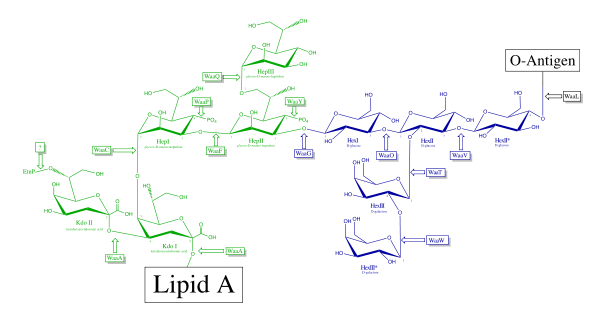- Core oligosaccharide
-
Core oligosaccharide (or Core-OS) is a short chain of sugar residues within Gram-negative lipopolysaccharide (LPS). Core-OS are highly diverse among bacterial species and even within strains of species [1]
Contents
Structure
The core domain always contains an oligosaccharide component which attaches directly to lipid A and commonly contains sugars such as heptose and 3-deoxy-D-mannooctulosonic acid (also known as KDO, keto-deoxyoctulosonate).[2] The LPS Cores of many bacteria also contain non-carbohydrate components, such as phosphate, amino acids, and ethanolamine substitutents.
Many core structures have been described in the literature, this description is based on the traditional general structure (as found in enteric bacteria and Pseudomonads). See the figure above for an overview of the structure found in E. coli R1.
Inner core
The "base" of the inner core is 1–3 KDO residues. The last KDO is often modified with a phosphate or ethanolamine group. From the KDOs, there are attached 2–3 heptoses (i.e. L-glycero-D-mannoheptulose) that are usually phosphorylated. These KDO and heptoses comprise the "inner core". The ketosidic bond between KDO and lipid A (α2→6) is especially susceptible to acid cleavage. LPS researchers use a weak acid treatment to separate the lipid and polysaccharide portions of LPS.
An LPS molecule that includes only a lipid A and an inner core (or less. See example) is referred to as "deep-rough LPS".
Outer core
The outer core is made of hexose residues that are attached to the last heptose residue in the inner core. Hexoses often found in the outer core include: D-glucose, D-mannose, D-galactose, etc.. There is usually at least three hexoses bound β1→3, with the O antigen being ligated to the third hexose. Other hexose are often found attached to the outer core, branching from the main oligomer.
LPS that include lipid A and a complete core oligosaccharide (inner and outer) is referred to as "rough LPS."
Biosynthesis
Function
See also
References
- ^ a b Heinrichs, David E.; Yethon, Jeremy A.; Whitfield, Chris (1998). "Molecular basis for structural diversity in the core regions of the lipopolysaccharides of Escherichia coli and Salmonella enterica". Molecular Microbiology 30 (2): 221–232. doi:10.1046/j.1365-2958.1998.01063.x. PMID 9791168.
- ^ Hershberger C and Binkley SB (1968). "Chemistry and Metabolism of 3-Deoxy-d-mannooctulosonic Acid. I. STEREOCHEMICAL DETERMINATION". Journal of Biological Chemistry 243 (7): 1578–1584. PMID 4296687. http://www.jbc.org/cgi/reprint/243/7/1578?maxtoshow=&HITS=10&hits=10&RESULTFORMAT=&fulltext=3-Deoxy-D-mannooctulosonic+Acid+&searchid=1&FIRSTINDEX=0&volume=243&issue=7&resourcetype=HWCIT.
Categories:- Glycolipids
Wikimedia Foundation. 2010.


